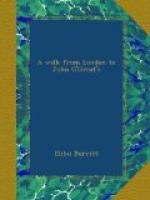two distended jaws. Now, the leading idea of
this device is involved in a tempting obscurity, which
leads one, at first sight, into different lines of
conjecture. What did the designer of this group
of statuary really intend to represent? Was
it to let the outside world know that, in that inn,
the “Roast Beef of Old England” was always
to be found par excellence? If so, would a man’s
mouth swallowing a bull whole, and apparently alive,
with hide and horns, tend to stimulate the appetite
of a passing traveller, and to draw him into the establishment?
But leaving these ambiguous symbols to be interpreted
by the passing public according to different perceptions
of their meaning, how many in a thousand would guess
aright the name given to the tavern by these tokens?
Would not ninety-nine in a hundred say, “The
Mouth and Bull,” to be sure, not only on the
principle that the major includes the minor, but also
because the human element is entitled to precedence
in the picture? But the ninety-nine would be
completely mistaken, if they adopted this natural
conclusion. They would find they had counted
without their host, who knows better than they the
relative position and value of things. What
has the law of logic to do with fat beef? The
name of his famous hotel is “THE BULL AND MOUTH;”
and few in London have attained to its celebrity as
a historical building. One is apt to wonder
if this precedence given to the beast is really incidental,
or adopted to give euphony to the name of an inn, or
whether there is a latent and spontaneous leaning to
such a method of association, from some cause or other
connected with perceptions of personal comfort afforded
at such establishments. Accidental or intentional,
this form of association is very common. There
is no tavern in London better known than The Elephant
and Castle, a designation that would sound equally
well if the two substantives were transposed.
Even the loftiest symbols of sovereignty often occupy
the secondary place in these compound titles.
There are, doubtless, a hundred inns in Great Britain
bearing the name of The Rose and Crown, but not one,
to my knowledge, called “The Crown and Rose.”
The same order obtains in sporting sections and terminology.
It is always “The Hare and Hounds;”
never “Hounds and Hare.”
This characteristic in itself is very interesting, and no American, with an eye to the unique, would like to see it changed. But if the more syntax of hotel names in England is so pleasant for him to study, how much more admirable is their variety! He has read at home of many of them in lively romance and grave history but he finds here that not half has been told him. He is familiar with the Lions, Red, White, and Black; the Bulls and Boars of the same colors; the Black and White Swans and Harts; the Crown and Anchor, the Royal George, Queen’s Head, and a few others of similar designation. These names have figured in volumes of English literature




